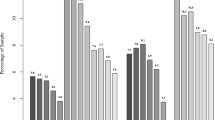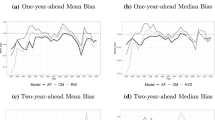Abstract
There is a long history of research which examines the relation between unexpected earnings and unexpected returns on common stock. Early literature used simple linear regression models to describe this relation. Recently, a number of authors have proposed nonlinear models. These authors find that the earnings-returns relation is approximately linear for small changes but is 'S'-shaped globally. However, unexpected earnings are generated by the sum of a measurement error and a true earnings innovation, so the apparent nonlinearity could be an artifact of nonlinearity in the measurement errors. Using a research design that minimizes the presence of measurement errors, we provide evidence consistent with the hypothesis that measurement errors contribute to the nonlinearities in the earnings-returns relation. While we are not suggesting that the earnings-returns relation is linear, our evidence suggests that there is no advantage to using a nonlinear model for large firms that are widely followed by analysts.
Similar content being viewed by others
References
Abarbanell, J.S., W.N. Lanen and R.E. Verrechia, “Analysts' forecasts as proxies for investor beliefs in empirical research.” Journal of Accounting and Economics 20, 31–60, (1996).
Abdel-khalik, A.R. “Specification problems with information content of earnings: revisions and rationality of expectations and self-selection bias.” Contemporary Accounting Research 7, 142–172 (1990).
Ball, R., S.P. Kothari and R.L. Watts, “Economic determinants of the relation between earnings changes and stock returns.” The Accounting Review 68, 622–638, (1993).
Beneish, M.D., “Stock prices and the dissemination of analysts' recommendations.” Journal of Business 64, 393–416, (1991).
Beneish, M.D. and C.R. Harvey, “A new approach to estimating the earnings response function.” Working paper, Duke University, (1990).
Bernard, V.L. and J.K. Thomas, “Post-announcement drift: Delayed price response or risk premium?” Journal of Accounting Research 27, 1–36, (1989).
Brown, L.D., “Earnings Forecasting Research: Its Implications for Capital Markets Research.” Journal of International Forecasting 9, 295–320, (1993).
Brown, L., P. Griffin, R. Hagerman, and M. Zmijewski, “Security analyst superiority relative to univariate time series models in forecasting quarterly earnings.” Journal of Accounting and Economics 9, 61–87, (1987).
Cacoullos, T., “Estimation of a multivariate density.” Annals of the Institute of Mathematical Statistics 18, 176–189, (1996).
Chambers, A.E. and Penman, S.H., “Timeliness of reporting and the stock price reaction to earnings announcements.” Journal of Accounting Research 22, 21–47, (1984).
Cheng, C.S.A., W.S. Hopwood and J.C. McKeown, “Nonlinearity and specification problems in unexpected earnings response regression model.” The Accounting Review 67, 379–398, (1992).
Cleveland, W.S. and S.J. Devlin, “Locally weighted regression: An approach to regression analysis by local fitting.” Journal of the American Statistical Assocation 83, 596–609, (1988).
Collins, D.W. and S.P. Kothari, “An analysis of intertemporal and cross-sectional determinants of earnings response coefficients.” Journal of Accounting and Economics 11, 143–181, (1989).
Cornell, B., and Landsman, W.R., “Security price response to quarterly earnings announcements and analysts' forecast revisions.” The Accounting Review 64, 680–692, (1989).
Christie, A.A., “On cross-sectional analysis in accounting research” Journal of Accounting and Economics 9, 231–258, (1987).
Das, S. and B. Lev, “Nonlinearity in the returns-earnings relation: Tests of alternative specification and explanations.” Contemporary Accounting Review 11, 353–379, (1994).
Easton, P. and M. Zmijewski, “Cross-sectional variation in the stock market response to accounting earnings announcements.” Journal of Accounting and Economics 11, 117–141, (1989).
Fama, E.F. and K.R. French, “Business conditions and expected returns on stocks and bonds.” Journal of Financial Economics 25, 23–50, (1989).
Fama, E.F. and K.R. French, “The cross section of expected returns.” Journal of Finance 42, 427–466, (1992).
Freeman, R.N. and S. Tse, “A nonlinear model of security price responses to unexpected earnings.” Journal of Accounting Research 30, 185–209, (1992).
Fukunaga, K., Introduction to statistical pattern recognition, New York: Academic Press, 1972.
Gallant, A.R., “On the bias in flexible functional forms and an essentially unbiased form: The Fourier flexible form.” Journal of Econometrics 15, 211–224, (1981).
Granger, C.W.J. and P. Newbold, Forecasting economic time series, New York: Academic Press, 1986.
Hansen, L.P., “Large sample properties of generalized method of moment estimators.” Econometrica 50, 1029–1054, (1982).
Härdle, W., Applied Nonparametric Regression. Cambridge University Press, 1990.
Hughes, J.S. and Ricks, W.E., “Association between forecast errors and excess returns near to earnings announcements.” The Accounting Review 62, 158–175, (1987).
Keim, D.B. and R.F. Stambaugh, “Predicting returns in the bond and stock market.” Journal of Financial Economics 17, 357–390, (1986).
Lang, M., “Time-varying stock price responses to earnings induced by uncertainty about the time-series properties of earnings.” Journal of Accounting Research 27, 229–257, (1991).
Lev, B., “On the usefulness of earnings and earnings research: Lessons and directions from two decades of empirical research.” Journal of Accounting Research Supplement 27, 153–192, (1989).
Mizrach, B., “Multivariate nearest-neighbour forecasts of EMS exchange rates.” Journal of Applied Econometrics 7, S151–S163, (1992a).
Mizrach, B., Forecast comparison in L2, Working paper, Federal Reserve Bank of New York, (1992b).
Pagan, A. and G.W. Schwert, “Alternative models for conditional stock volatility.” Journal of Econometrics 45, 267–290, (1990).
Parzen, E., “On the estimation of probability density and mode.” Annals of Mathematical Statistics 33, 1065–1076, (1962).
Philbrick, D.R. and W.E. Ricks, “Using Value Line and IBES analysts forecasts in accounting research.” Journal of Accounting Research 29, 397–415, (1991).
Schipper, K., “Analysts' forecasts.” Accounting Horizons 5, 105–121, (1991).
Silverman, B.W., Density estimation for statistics and data analysis, London: Chapman and Hall, 1986.
White, H., “A heteroskedasticity-consistent covariance matrix estimator and a direct test for heteroskedasticity.” Econometrica 48, 817–838, (1980).
Author information
Authors and Affiliations
Rights and permissions
About this article
Cite this article
Beneish, M., Harvey, C. Measurement Error and Nonlinearity in the Earnings-Returns Relation. Review of Quantitative Finance and Accounting 11, 219–247 (1998). https://doi.org/10.1023/A:1008362715659
Issue Date:
DOI: https://doi.org/10.1023/A:1008362715659




